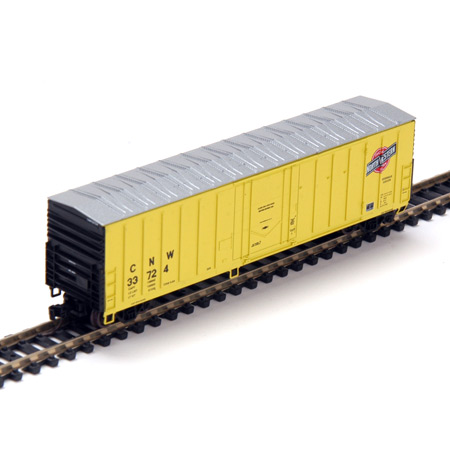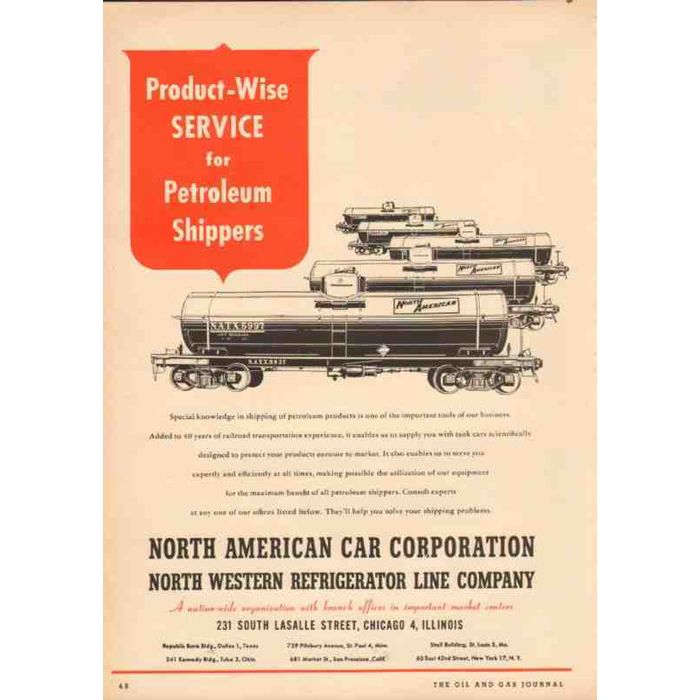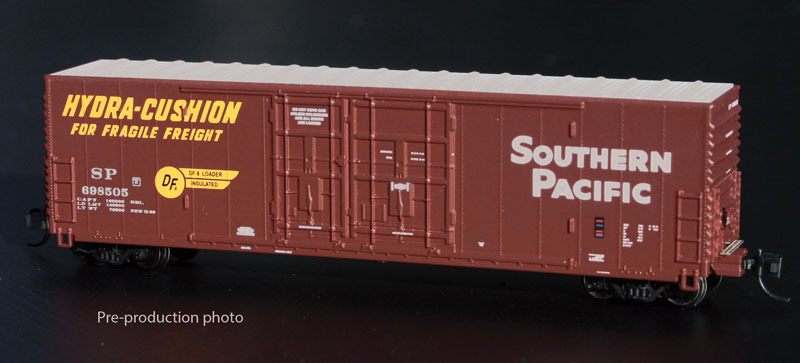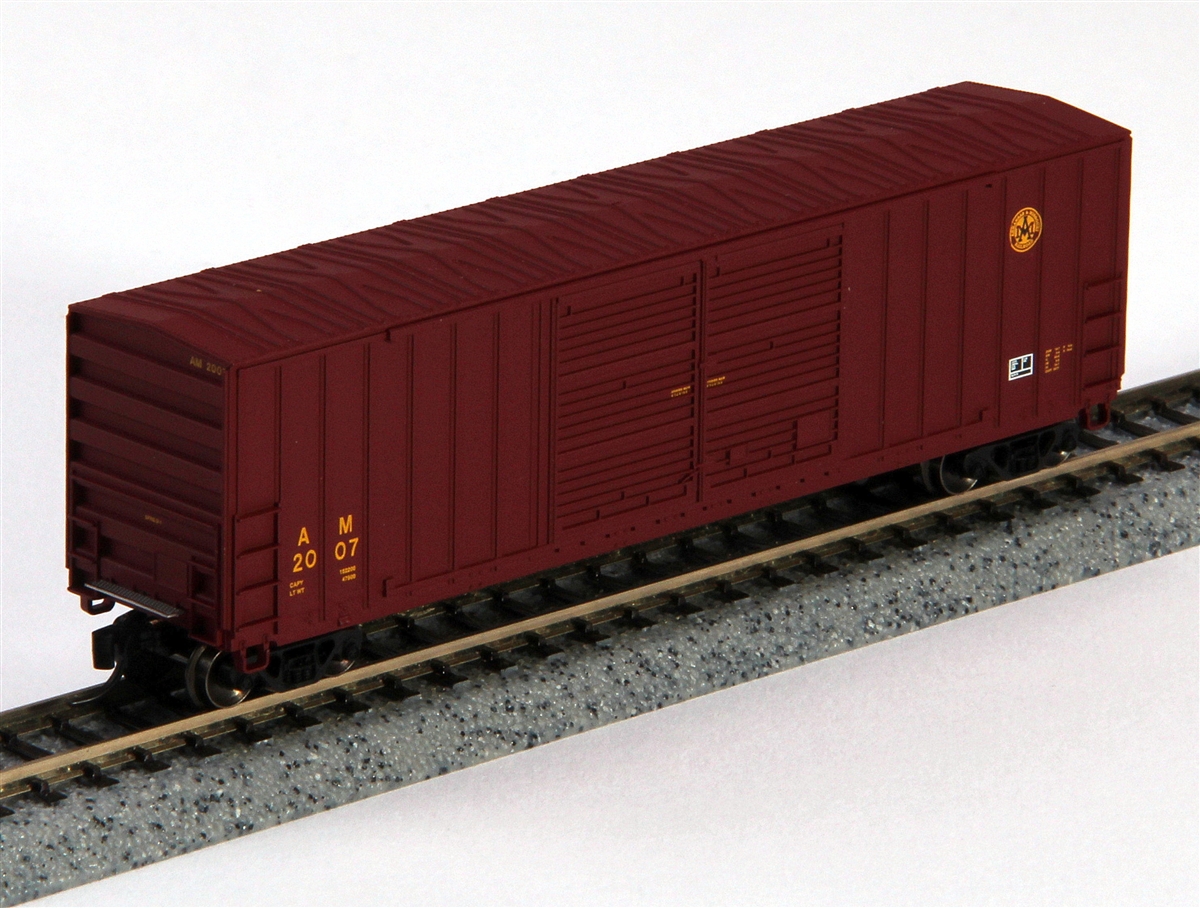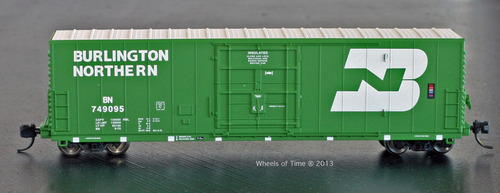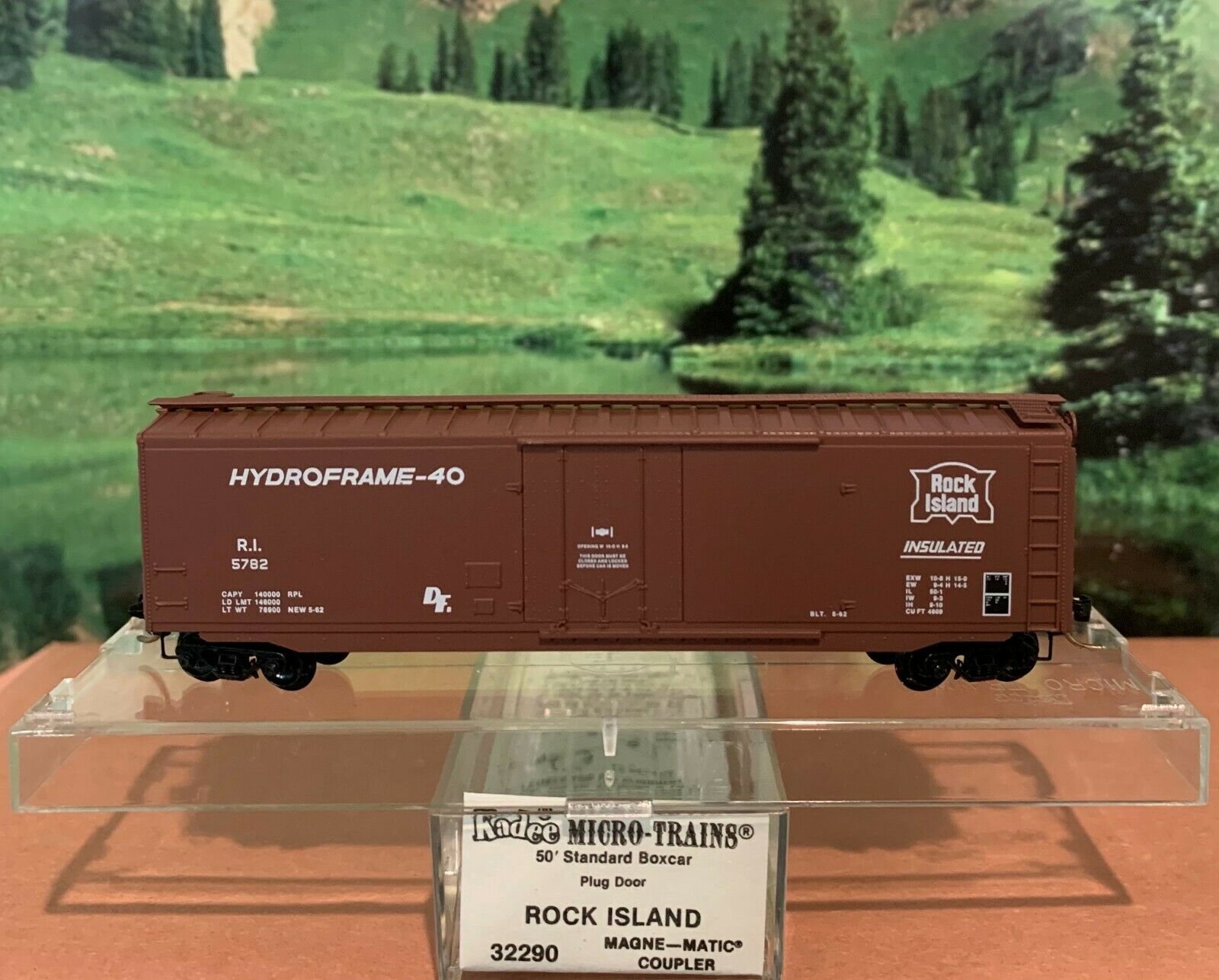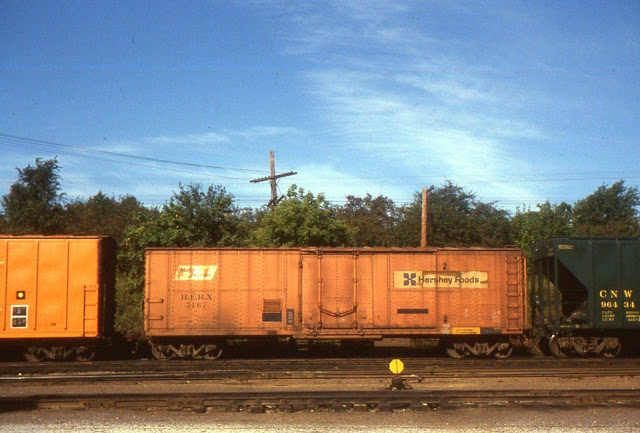Model Information: MODEL FEATURES:
- Three road numbers
- Etched metal stirrup steps
- Fully-assembled and ready-to-run out of the box
- Accurately painted and printed
- Highly detailed, injection molded body
- Detailed, molded underframe
- Weighted for trouble free operation
- N-scale 70 ton trucks with machined 33" metal wheels operate on all popular brands of track
- Body mounted McHenry operating scale knuckle couplers
- Clear plastic jewel box for convenient storage
- Minimum radius: 9"
- Three road numbers
- Etched metal stirrup steps
- Fully-assembled and ready-to-run out of the box
- Accurately painted and printed
- Highly detailed, injection molded body
- Detailed, molded underframe
- Weighted for trouble free operation
- N-scale 70 ton trucks with machined 33" metal wheels operate on all popular brands of track
- Body mounted McHenry operating scale knuckle couplers
- Clear plastic jewel box for convenient storage
- Minimum radius: 9"
Prototype History: The 50’ NACC boxcar was designed and built by the North American Car Corporation (NACC) in the early 1960s. The car was an insulated boxcar equipped with a plug-door. Insulated cars are used to carry various commodities that are temperature sensitive. The plug door offers better sealing of the car to maintain temperature and better protection from weather, theft, and other possible damages.
North American Car built the 50600-50624 series in 1965, and the 50625-50674 in May, 1966 for lease to the Rio Grande. These exterior post cars were assembled by North American using Stanray roofs and ends, Keystone cushioned underframes, 10 foot Superior plug doors, and either Euipco or Evans load divider bulkheads and side fillers. The 50600-50624 had Morton perforated running boards but the 50625-50674 were built without roof walks and full-height side ladders which were to be banned beginning January 1, 1967. Both series used Wabcopac truck mounted brake cylinders and the livery was modified to delete the silver paint below the black stripe. The 50638 was assigned for loading on the New York Central (which was shown in the picture) These cars were returned to North American by 1972 and were replaced by more modern reefers with the same numbers.
North American Car built the 50600-50624 series in 1965, and the 50625-50674 in May, 1966 for lease to the Rio Grande. These exterior post cars were assembled by North American using Stanray roofs and ends, Keystone cushioned underframes, 10 foot Superior plug doors, and either Euipco or Evans load divider bulkheads and side fillers. The 50600-50624 had Morton perforated running boards but the 50625-50674 were built without roof walks and full-height side ladders which were to be banned beginning January 1, 1967. Both series used Wabcopac truck mounted brake cylinders and the livery was modified to delete the silver paint below the black stripe. The 50638 was assigned for loading on the New York Central (which was shown in the picture) These cars were returned to North American by 1972 and were replaced by more modern reefers with the same numbers.
Road Name History: The Chicago and North Western Transportation Company (reporting mark CNW) was a Class I railroad in the Midwestern United States. It was also known as the North Western. The railroad operated more than 5,000 miles (8,000 km) of track as of the turn of the 20th century, and over 12,000 miles (19,000 km) of track in seven states before retrenchment in the late 1970s.
Until 1972, when the company was sold to its employees, it was named the Chicago and North Western Railway. The C&NW became one of the longest railroads in the United States as a result of mergers with other railroads, such as the Chicago Great Western Railway, Minneapolis and St. Louis Railway and others.
By 1995, track sales and abandonment had reduced the total mileage back to about 5,000. The majority of the abandoned and sold lines were lightly trafficked branches in Iowa, Illinois, Minnesota, South Dakota and Wisconsin. Large line sales, such as those that resulted in the Dakota, Minnesota and Eastern Railroad further helped reduce the railroad to a mainline core with several regional feeders and branches.
The company was purchased by Union Pacific Railroad (UP) in April 1995 and ceased to exist.
Until 1972, when the company was sold to its employees, it was named the Chicago and North Western Railway. The C&NW became one of the longest railroads in the United States as a result of mergers with other railroads, such as the Chicago Great Western Railway, Minneapolis and St. Louis Railway and others.
By 1995, track sales and abandonment had reduced the total mileage back to about 5,000. The majority of the abandoned and sold lines were lightly trafficked branches in Iowa, Illinois, Minnesota, South Dakota and Wisconsin. Large line sales, such as those that resulted in the Dakota, Minnesota and Eastern Railroad further helped reduce the railroad to a mainline core with several regional feeders and branches.
The company was purchased by Union Pacific Railroad (UP) in April 1995 and ceased to exist.
Brand/Importer Information: Athearn's history began in 1938, when its founder-to-be, Irvin Athearn, started an elaborate O scale layout in his mother's house. After placing an ad selling the layout, and receiving much response to it, Irv decided that selling model railroads would be a good living. He sold train products out of his mother's house through most of the 1940s. After becoming a full-time retailer in 1946, Irv opened a separate facility in Hawthorne, California in 1948, and that same year he branched into HO scale models for the first time.
Athearn acquired the Globe Models product line and improved upon it, introducing a comprehensive array of locomotive, passenger and freight car models. Improvements included all-wheel drive and electrical contact. One innovation was the "Hi-Fi" drive mechanism, employing small rubber bands to transfer motion from the motor spindle to the axles. Another was the double-ended ring magnet motor, which permitted easy connection to all-wheel-drive assemblies. Athearn was also able to incorporate flywheels into double-ended drives.
The company produced a model of the Boston & Maine P4 class Pacific steam locomotive which incorporated a cast zinc alloy base and thermoplastic resin superstructure. It had a worm drive and all power pickup was through the bipolar trucks that carried the tender. This item was discontinued after the Wilson motor was no longer available, and was not redesigned for a more technologically advanced motor.
Athearn's car fleet included shorter-than-scale interpretations of passenger cars of Southern Pacific and Atchison, Topeka & Santa Fe Railroad prototypes. The company also offered a variety of scale-length freight cars with sprung and equalized trucks. The cars could be obtained in simple kit form, or ready-to-run in windowed display boxes. The comprehensive scope of the product line contributed to the popularity of HO as a model railroad scale, due to the ready availability of items and their low cost.
Irv Athearn died in 1991. New owners took control in 1994, but continued to follow Athearn's commitment to high-quality products at reasonable prices. Athearn was bought in 2004 by Horizon Hobby. Athearn was then moved from its facility in Compton to a new facility in Carson, California. In mid-2009, all remaining US production was moved to China and warehousing moved to parent Horizon Hobby. Sales and product development was relocated to a smaller facility in Long Beach, California.
Read more on Wikipedia and Athearn website.
Athearn acquired the Globe Models product line and improved upon it, introducing a comprehensive array of locomotive, passenger and freight car models. Improvements included all-wheel drive and electrical contact. One innovation was the "Hi-Fi" drive mechanism, employing small rubber bands to transfer motion from the motor spindle to the axles. Another was the double-ended ring magnet motor, which permitted easy connection to all-wheel-drive assemblies. Athearn was also able to incorporate flywheels into double-ended drives.
The company produced a model of the Boston & Maine P4 class Pacific steam locomotive which incorporated a cast zinc alloy base and thermoplastic resin superstructure. It had a worm drive and all power pickup was through the bipolar trucks that carried the tender. This item was discontinued after the Wilson motor was no longer available, and was not redesigned for a more technologically advanced motor.
Athearn's car fleet included shorter-than-scale interpretations of passenger cars of Southern Pacific and Atchison, Topeka & Santa Fe Railroad prototypes. The company also offered a variety of scale-length freight cars with sprung and equalized trucks. The cars could be obtained in simple kit form, or ready-to-run in windowed display boxes. The comprehensive scope of the product line contributed to the popularity of HO as a model railroad scale, due to the ready availability of items and their low cost.
Irv Athearn died in 1991. New owners took control in 1994, but continued to follow Athearn's commitment to high-quality products at reasonable prices. Athearn was bought in 2004 by Horizon Hobby. Athearn was then moved from its facility in Compton to a new facility in Carson, California. In mid-2009, all remaining US production was moved to China and warehousing moved to parent Horizon Hobby. Sales and product development was relocated to a smaller facility in Long Beach, California.
Read more on Wikipedia and Athearn website.
Item created by: Lethe on 2016-08-28 19:18:30. Last edited by gdm on 2018-03-16 09:38:37
If you see errors or missing data in this entry, please feel free to log in and edit it. Anyone with a Gmail account can log in instantly.
If you see errors or missing data in this entry, please feel free to log in and edit it. Anyone with a Gmail account can log in instantly.


